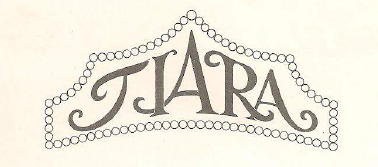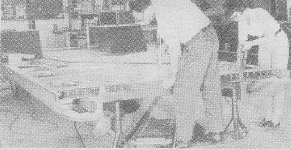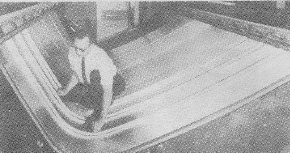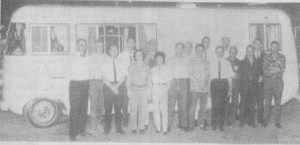Tiara, the forgotten child

Transcribed from Whales on Wheels (WoW), 1994-3 & 1994-4, written by W. Christy Barden, continuous club member and Ultra Van owner since 1973, UV #228 & UV #603. Past president of Group Ultra Van, 1983-1986 and newsletter editor of WoW from the first edition in 1983 through to mid-2000.
This is from written from an interview with Mike Kelly, and Ultra Van employee.

The Tiara motor home is a direct descendant of the Ultra Van. It has always been considered part of the Ultra Van “family.” The 600 series Ultra Van was influenced by the Tiara. They all had a connection. That connection started with Dave Peterson. He designed and built the Ultra Van in a small warehouse in Oakland California in 1961. In 1965 Jack Tillotson from Kansas City bought the operation and brought to the Hutchinson Air Base Industrial Tract (HABIT) which was an old Navy Base south of the City. There they build about 354 Ultra Vans, starting with number 215 in 1966 and finishing with number 558 in 1970. There were about 21 Tiara’s built after that at HABIT. The last one is still owned by the Tillotson family, never registered, and kept in their place in the Ozarks.
In 1969 it became evident that the Corvair production was going to be ended. That meant Ultra Van had to find and alternate power plant. A guy was brought in from the Hydraulics division of Cessna Aircraft to be chief engineer to do the V-8 conversion. They decided on the Chevrolet 307 V-8. The engine was placed in the rear but backwards. The drive shaft went forward into a marine V-drive, which sent it back to a Corvette differential. Because of this the old modified late model Corvair suspension could not be used. The 1969 Corvette suspension was used in a modified form. It was not well engineered and presented some problems. The Tillotson’s knew from the demeanor of the people in the plant that the V/8 with the V drive wasn’t going to work, a major redesign was going to be necessary. They thought it best to set the entire Ultra Van design aside and an develop a new motor home based on the Oldsmobile Toronado 375 horsepower, front drive assembly. Mike said the idea to use the front drive Toronado was from the brother of the shop manager who used them to build air transports in Georgia. Thus the Tiara was born.
The specifications of the Tiara are as follows: Length 23 feet; width 94 inches; height 8 feet, 6 inches; 173 inch wheel base; All aircraft grade aluminum (which added to the weight) monocoque construction; 40 gallon gasoline tank; 50 gallon fresh water and holding tanks; Empty weight about 6,300 pounds; Oldsmobile Toronado, front wheel drive 375 HP 455 cubic inch engine; the 1970 selling price was $14, 650.
Mike Kelly, an Ultra Van employee, talked about his friend Dick Erb as being the one who came up with the football shape of the 4 corners of the unit. He said if you take a football, cut off the top and bottom, then section it into 4 quarters. Take these quarters and use them on the four corners of the Tiara, it gives them a barrel shape on the corners. All the compound curves were done on a stretch press in Wichita. Even the 42 windshields made by Sake-Lite in Wichita have a barrel shape to them. This barrel shape on the four corners are all connected by straight lines, with a flat front and back, which gives it its basic design. Mike designed and built the jig that the forward section was set up on. The center floor section is two welded and rolled pieces of aluminum for the rocker panels.

These are fitted into a jig with the outriggers or bulkheads. Wiring and plumbing lines are run in these rocker panels. The floor comes on top of the rocker panels. This extends from the base of the front bucket seats to behind the rear wheel wells. The forward part was mated to this center section. The wall and ceiling are one piece with the ribs held in place by using an adhesive instead of rivets.

This gave the roof and wall a clean look. The walls and half ceiling are set in place and joined and sealed in the center of the roof. The smooth roof line is not marred with a miscellaneous assortment of stacks, vents, air conditioners, etc. There are two small vent pipes, for the sink and shower, and the roof vent for the bath. Then the rear section was added. There is no chassis, this was a direct descendent of the Ultra Van. On the 600 series Ultra Van Dave Peterson took this idea of the welded rolled rocker panels and did it one better. He designed a special rocker panel and had it extruded in aluminum and used this as the bases for construction of the 600 series.
Mike Kelly was born in Lawrence Kansas in 1920 and grew up in the Wichita area. These were the hard times of the dust bowl era. Married in 1941, engaged in farming until 1952, had 5 children. In 1952 he went to work for Boeing Aircraft in Wichita and was laid off during the 1967 dip in the aircraft industry. It was at this time he first saw the Ultra Van. There was a showing of the Ultra Van at the Broadview Hotel in Wichita. Mike said he was impressed with it. The showing was in a good setting at the hotel and drew much interest. Mike told a friend, Dick Erb, that Dick should go down to Hutchinson and see about getting a job at Ultra Van. He did that and got a job. Shortly afterwards Dick asked Mike to come to work there also for he could see they needed Mikes expertise as engineering draftsman. Mike drew Tiara plans, and re-works on Ultra Van components. Dick was the one that introduced bubbles (station numbers) to the Ultra Van drawings. This is done in aircraft, so you know where you are in the drawing by using the number. Small numbers up front going to larger numbers as you went toward the back of the Ultra Van. After Mike was there a week Dick was fired, he now works at Boeing in Wichita. Mr. Tillitson thought Dick was trying to palm off an old man (Mike) on them. After a month Mr. Tillotson came by and told Mike this and told him he was doing a good job and gave him a $50 raise. This put Mike on the good side of the Tillerson’s.
Before the Tiara there were some other attempts in engineering a new unit. An Oldsmobile Toronado was put in the front of an Ultra Van. It was to heavy a unit in the front, and the Ultra Van was to low of a profile to have the engine up front and have the room to put driving chairs in as well. Using up all that front driving and dinning area for an engine defeated the Ultra Van concept. Next, they tried to fit a Dodge truck chassis with a body. Using aluminum and stringers and panels and ribs, then skinning it with new plastic material. The material was heated and molded to fit the contour of the ribs. The material had a good memory, when placed in the hot sun the material tried to straighten out again. Mike said it was quite a sight to see the panels pop out again.
Mike related that toward the end young Mr. Tillotson brought a friend from Kansas City to run the operation at Hutchinson. His name was Mr. Burgess and was the president of Luscomb Aircraft Company. From what Mike said this new plant superintend brought with him much of the equipment from the Luscomb plant. He didn’t know what kind of a deal was made but intimated that Mr. Burgess made quite a bit of money selling this equipment to Ultra Van. Mr. Burgess offered Mike the plant managers job, but Mike turned it down. He didn’t want to fix the previous guys poor job. So, he worked on Tiara number 1, 2 and 3 and then was let go. Mike worked there one year and three months to shut down. It was the end of Ultra Van. Old man Tillitson has set a limit of three million dollars, and they were whizzing right past it and he shut the operation down. Mike felt purchasing inefficiencies didn’t help. Wrong parts were order and not returned, there was no control. The managers reorganized and started a company called BELCO which finished the production of the Tiara in the same plant at the Hutchinson airfield. Mike related that they kept all the chiefs (who he felt contributed to the Ultra Van’s demise) and fired all the Indians. BELCO became Collins Industries and went on to manufacture ambulances. Mr. Lewis Ediger President of Ultra Van became VP. at Collins.
Originally young Mr. Tillitson encouraged his father to pursue the Ultra Van project to ease him out of the publishing business. They ran Modern Handicraft Publications, which put out “Work Basket” and “Work Bench.” Mike said they grossed one million a month with this business, but the expense of the Ultra Van operation was too much of an offset to their profits. The operation had passed the three million mark set by old man Tillotson and he shut it down.
Mike drove a 9167 Mustang back and forth to work from Wichita and his son Robert remembers him coming and going. During that time there were about 100 people working at Ultra Van. Mike talked about the gymnasium floor and how easy it was on the feet and legs. You could work for hours on a good wood floor, as compared to a concrete floor that would get the legs hurting in a few hours. He really liked that. When the Airbase was built there were many Amish people that were displaced from the land. Some of them worked at Ultra Van. He describes them as “work horses” as they did good work.
Mike said this was one of his best work experiences he had. He was involved in engineering, sales, production, etc. He remembered going to the RV show in Louisville with Jim Howser, he owned Motor Coach Co. a motor home dealer in Charlotte North Carolina who sold over 40 Ultra Vans. It was Mr. Tillotson policy that everyone from executives to line employees go out in a motor home and find firsthand what it’s like. The was easy to Mike for he had always had an interest in motor homes. He currently owns GMC Birchaven 23-foot motor home. It shows a June 28, 1978 manufacture date by Coachman Inc. GMC stopped building these unites in 1976. I asked how could this be? He related a bank VP ordered it in 1978 along with two others. He has what he thinks might be last GMC motor homes built with serial number 1288-172852 (RVIA S/N 2443056) He is also involved in building a “roomy” motor home on his Ford one-ton chassis. After Ultra Van Mike worked at Beach Aircraft in Wichita for ten years as a tool design draftsman, and then retired.
Mr. Kelly offered the following list of personnel who worked at Ultra, Inc. during this time:
Jack Tillotson, Publisher of Work Basket and Work Bench; Lewis Ediger, President of Ultra Van V.P. of Colins Industries; Robert Lind, Purchasing Mgr. Ultra Van, retired V.P. Belco: Mr. Borgess Superintendent Ultra Van, President Luscomb Aircraft. Currently lives in Gain City, MO. Larry Knite, Sales Mgr. Downtown Hutchinson, KS; Wayne Nobbs, Engineer Ultra Van, Change Manufacturing (currently), 3115 Farmington Rd. Hutchinson, KS 67502. (316) 662-0863; Don Peters, Shop Foreman Ultra Van, Director Collins Industries; Jim Howser, Motor Coach Co. 210 Providence Rd., Charlotte, NC 28207. (704) 375-5631, Ultra dealer that sold some 40 Ultra Vans; Mike Kelly, 11002 W 21st., Wichita, KS 67205

